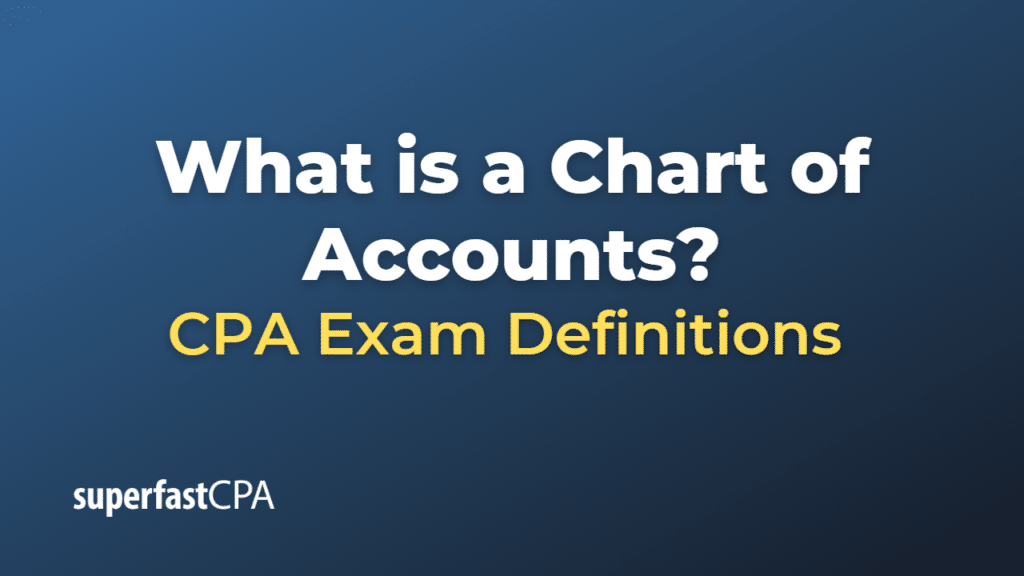Chart of Accounts
A Chart of Accounts (COA) is a comprehensive and organized list of all the accounts used by a business to track its financial transactions and prepare its financial statements. The Chart of Accounts serves as the foundation of a company’s accounting system, as it categorizes and records financial transactions in a structured manner, enabling the generation of accurate and meaningful financial reports.
The accounts in a Chart of Accounts are typically organized into the following categories, which reflect the structure of the financial statements:
- Assets: These accounts represent the resources owned by the business, such as cash, accounts receivable, inventory, buildings, equipment, and investments.
- Liabilities: These accounts represent the obligations and debts of the business, such as accounts payable, loans, and other financial obligations.
- Equity: These accounts represent the owners’ interest in the business, including contributed capital (common stock, preferred stock) and retained earnings.
- Revenue: These accounts represent the income generated from the sale of goods or services, as well as other sources of income, such as interest, dividends, and rental income.
- Expenses: These accounts represent the costs incurred by the business in its operations, such as salaries and wages, rent, utilities, depreciation, and advertising.
Each account in the Chart of Accounts is assigned a unique number, which helps to organize and classify the accounts, as well as facilitate data entry and report generation. The numbering system typically follows a standardized format, with different ranges of numbers assigned to each of the main categories (assets, liabilities, equity, revenue, and expenses).
The Chart of Accounts can be tailored to the specific needs and complexity of a business. A small business may have a relatively simple Chart of Accounts, while a larger organization with multiple departments or divisions may require a more detailed and extensive list of accounts.
It is essential to keep the Chart of Accounts up-to-date and organized, as it directly impacts the accuracy and usefulness of the company’s financial statements. Regular reviews and adjustments may be necessary to ensure that the Chart of Accounts accurately reflects the financial activities and structure of the business.
Example of a Chart of Accounts
Here’s a simplified example of a Chart of Accounts for a small retail business:
- Assets
1.1. Current Assets
1.1.1. Cash
1.1.2. Accounts Receivable
1.1.3. Inventory
1.2. Fixed Assets
1.2.1. Buildings
1.2.2. Equipment
1.2.3. Vehicles - Liabilities
2.1. Current Liabilities
2.1.1. Accounts Payable
2.1.2. Short-term Loans
2.1.3. Sales Tax Payable
2.2. Long-term Liabilities
2.2.1. Mortgage Payable
2.2.2. Long-term Loans - Equity
3.1. Owner’s Capital
3.2. Retained Earnings - Revenue
4.1. Sales Revenue
4.2. Interest Income
4.3. Other Income - Expenses
5.1. Cost of Goods Sold
5.2. Salaries and Wages
5.3. Rent Expense
5.4. Utilities Expense
5.5. Depreciation Expense
5.6. Advertising Expense
5.7. Interest Expense
This example provides a basic structure for the Chart of Accounts, which can be customized and expanded depending on the specific needs and complexity of the business. Each account is assigned a unique number, which can be used to classify and organize the accounts in the accounting system.
For instance, the Cash account may be assigned the number 1.1.1, the Accounts Receivable account may be assigned 1.1.2, and so on. This numbering system helps to maintain a clear and consistent structure in the Chart of Accounts, making it easier to manage, report, and analyze the business’s financial transactions.













